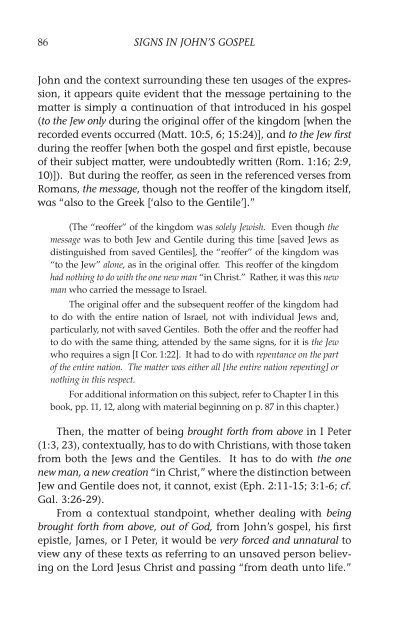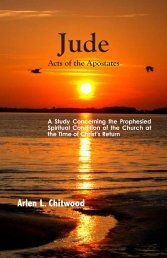Signs in John's Gospel - The Lamp Broadcast
Signs in John's Gospel - The Lamp Broadcast
Signs in John's Gospel - The Lamp Broadcast
You also want an ePaper? Increase the reach of your titles
YUMPU automatically turns print PDFs into web optimized ePapers that Google loves.
86 SIGNS IN JOHN’S GOSPEL<br />
John and the context surround<strong>in</strong>g these ten usages of the expression,<br />
it appears quite evident that the message perta<strong>in</strong><strong>in</strong>g to the<br />
matter is simply a cont<strong>in</strong>uation of that <strong>in</strong>troduced <strong>in</strong> his gospel<br />
(to the Jew only dur<strong>in</strong>g the orig<strong>in</strong>al offer of the k<strong>in</strong>gdom [when the<br />
recorded events occurred (Matt. 10:5, 6; 15:24)], and to the Jew first<br />
dur<strong>in</strong>g the reoffer [when both the gospel and first epistle, because<br />
of their subject matter, were undoubtedly written (Rom. 1:16; 2:9,<br />
10)]). But dur<strong>in</strong>g the reoffer, as seen <strong>in</strong> the referenced verses from<br />
Romans, the message, though not the reoffer of the k<strong>in</strong>gdom itself,<br />
was “also to the Greek [‘also to the Gentile’].”<br />
(<strong>The</strong> “reoffer” of the k<strong>in</strong>gdom was solely Jewish. Even though the<br />
message was to both Jew and Gentile dur<strong>in</strong>g this time [saved Jews as<br />
dist<strong>in</strong>guished from saved Gentiles], the “reoffer” of the k<strong>in</strong>gdom was<br />
“to the Jew” alone, as <strong>in</strong> the orig<strong>in</strong>al offer. This reoffer of the k<strong>in</strong>gdom<br />
had noth<strong>in</strong>g to do with the one new man “<strong>in</strong> Christ.” Rather, it was this new<br />
man who carried the message to Israel.<br />
<strong>The</strong> orig<strong>in</strong>al offer and the subsequent reoffer of the k<strong>in</strong>gdom had<br />
to do with the entire nation of Israel, not with <strong>in</strong>dividual Jews and,<br />
particularly, not with saved Gentiles. Both the offer and the reoffer had<br />
to do with the same th<strong>in</strong>g, attended by the same signs, for it is the Jew<br />
who requires a sign [I Cor. 1:22]. It had to do with repentance on the part<br />
of the entire nation. <strong>The</strong> matter was either all [the entire nation repent<strong>in</strong>g] or<br />
noth<strong>in</strong>g <strong>in</strong> this respect.<br />
For additional <strong>in</strong>formation on this subject, refer to Chapter I <strong>in</strong> this<br />
book, pp. 11, 12, along with material beg<strong>in</strong>n<strong>in</strong>g on p. 87 <strong>in</strong> this chapter.)<br />
<strong>The</strong>n, the matter of be<strong>in</strong>g brought forth from above <strong>in</strong> I Peter<br />
(1:3, 23), contextually, has to do with Christians, with those taken<br />
from both the Jews and the Gentiles. It has to do with the one<br />
new man, a new creation “<strong>in</strong> Christ,” where the dist<strong>in</strong>ction between<br />
Jew and Gentile does not, it cannot, exist (Eph. 2:11-15; 3:1-6; cf.<br />
Gal. 3:26-29).<br />
From a contextual standpo<strong>in</strong>t, whether deal<strong>in</strong>g with be<strong>in</strong>g<br />
brought forth from above, out of God, from John’s gospel, his first<br />
epistle, James, or I Peter, it would be very forced and unnatural to<br />
view any of these texts as referr<strong>in</strong>g to an unsaved person believ<strong>in</strong>g<br />
on the Lord Jesus Christ and pass<strong>in</strong>g “from death unto life.”



